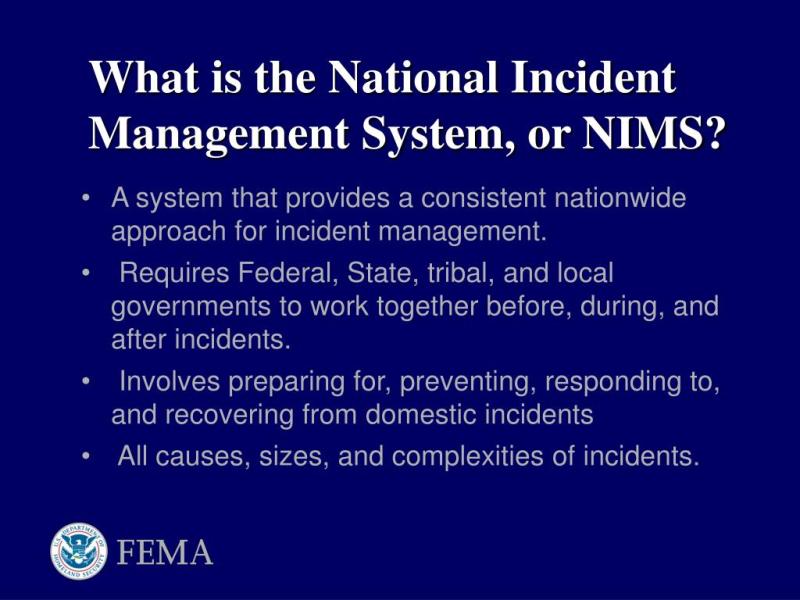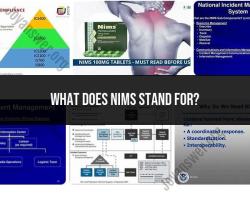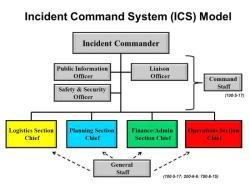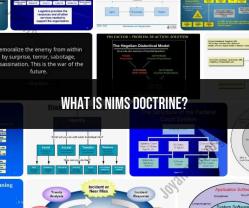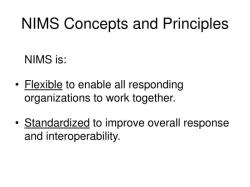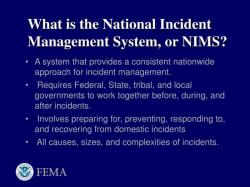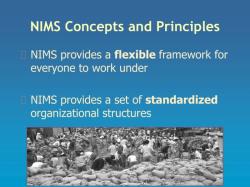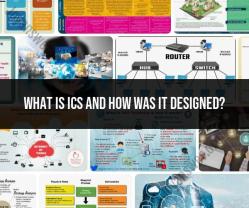What is the National Incident Management System (NIMS)?
The National Incident Management System (NIMS) is a comprehensive and standardized framework designed to enhance the coordination and effectiveness of incident management across various agencies and levels of government in the United States. NIMS provides a systematic approach for managing incidents, including natural disasters, acts of terrorism, and other emergencies.
Key components and principles of the National Incident Management System include:
Common Terminology: NIMS establishes a common language and terminology to ensure that responders from different agencies can communicate effectively during incidents. This helps avoid confusion and promotes a shared understanding of roles and responsibilities.
Unified Command: NIMS promotes the use of a Unified Command structure, where multiple agencies and jurisdictions work together to manage incidents. This collaborative approach ensures that all stakeholders contribute to decision-making processes and resource allocation.
Integrated Communications: Effective communication is crucial during incidents. NIMS emphasizes integrated communications systems that enable seamless information sharing among responding agencies. This helps ensure that everyone involved has access to the information they need.
Modular Organization: NIMS encourages a modular organizational structure that can expand or contract based on the size and complexity of an incident. This flexibility allows for the efficient allocation of resources and the adaptation of the response to changing conditions.
Incident Command System (ICS): ICS is a key component of NIMS and provides a standardized organizational structure for incident management. It includes key roles such as Incident Commander, Operations Section Chief, Planning Section Chief, Logistics Section Chief, and Finance/Administration Section Chief.
Resource Management: NIMS emphasizes the effective and efficient management of resources, including personnel, equipment, and supplies. Resource management principles help ensure that resources are deployed where they are needed most.
Accountability: Accountability is crucial during incident response. NIMS establishes mechanisms to track the location and status of resources, personnel, and tasks to ensure that all efforts are coordinated and accounted for.
Training and Exercises: NIMS promotes training and regular exercises to ensure that personnel are familiar with the system and can effectively implement its principles during real incidents. This helps improve overall preparedness and response capabilities.
NIMS is not only applicable to government agencies but is also encouraged for use by non-governmental organizations, private-sector entities, and individuals involved in emergency management and response. The system is intended to create a unified and coordinated approach to incident management that improves the overall effectiveness of emergency response efforts. Federal agencies, states, tribal nations, and local jurisdictions are encouraged to adopt and implement NIMS to ensure a seamless and collaborative response to incidents of all types and sizes.
What exactly is the National Incident Management System (NIMS) and how does it function?
The National Incident Management System (NIMS) is a standardized framework established in the United States to guide all levels of government, non-governmental organizations (NGOs), and the private sector in effectively responding to a wide range of incidents, regardless of their cause, size, location, or complexity. It aims to promote interoperability and collaboration among different entities by establishing common terminology, procedures, and structures.
Key Functions of NIMS:
- Prevention: NIMS provides guidance on assessing risks, developing plans, and implementing mitigation strategies to prevent incidents from occurring or minimizing their impact.
- Preparedness: It outlines procedures for training personnel, acquiring resources, and maintaining readiness to respond to potential incidents.
- Response: NIMS establishes a standardized Incident Command System (ICS) that provides a flexible and scalable framework for managing incident response operations. This includes assigning roles and responsibilities, establishing communication channels, and coordinating resource deployment.
- Recovery: NIMS emphasizes the importance of long-term recovery efforts, including damage assessment, debris management, and providing assistance to affected communities.
- Mitigation: It encourages continuous improvement by analyzing lessons learned from past incidents and implementing measures to reduce their future occurrence.
Components of NIMS:
- Core Principles: Six guiding principles that serve as the foundation for the NIMS framework, including flexibility, scalability, and unified command.
- Standards and Best Practices: Documented procedures and guidelines for implementing NIMS principles and functions.
- Training and Qualifications: Programs for educating and training personnel on NIMS principles and practices.
- Resources: A network of personnel, equipment, and facilities available for incident response.
- Technology: Tools and systems for communication, information sharing, and situational awareness during incidents.
Benefits of NIMS:
- Improved interoperability and collaboration: NIMS facilitates cooperation among different entities by providing a common language and framework for working together.
- Enhanced incident response: The standardized ICS structure improves decision-making and resource allocation during incidents.
- Reduced costs and damage: Effective prevention, preparedness, and response efforts can minimize the financial and societal costs of incidents.
- Increased safety and security: NIMS promotes a safer environment for responders and communities by reducing risks and mitigating hazards.
Overall, NIMS plays a crucial role in ensuring effective and coordinated incident management across the United States. By promoting collaboration, standardization, and continuous improvement, it helps to protect lives, property, and communities from a wide range of threats.
